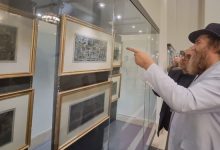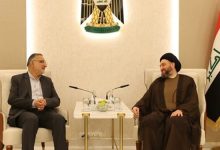Zarghami in the ceremony of honoring the lasting faces of cultural heritage: The pride of cultural heritage is our birth certificate

According to the tourism reporter of Fars News Agency, on Thursday evening, 27 June 1402, the second ceremony honoring the lasting figures of the field of cultural heritage was held in the amphitheater of the Ministry of Cultural Heritage, Handicrafts and Tourism.

At the beginning of this ceremony, the Deputy Minister of Cultural Heritage, Ali Darabi, spoke and said: Undoubtedly, when we talk about cultural heritage, civilization, identity, and history, Hakim Tus and the creator of the Shahnameh stand at the top after one thousand and forty-two years. It radiates.
He added: The universal and inexhaustible masterpiece of the Shahnameh has 50,000 lines of poetry, which mentions the word Iran more than 2,000 times and wisdom and wisdom more than 600 times, and this is the cultural and historical background of us Iranians.
Darabi continued: Although the Shahnameh was written by Hakim Tus, it is as if all Iranians wrote this epic together with him. And therefore, we should call the Shahnameh the civil registration document of Iranians and the history book of Iran.
He added: honoring, promoting and introducing these honors means bowing and disrespecting the Persian language and Islam, which throughout history have been two elements that give identity, create unity, give unity and create national security and political stability in a large territory called Iran.
Darabi continued: Therefore, when we talk about cultural heritage, it is a reflection of values and a social narrative of the biocultural experience of humans throughout history.
Deputy Minister of Culture Mirraath Farhani said: The wise leader of the Islamic Revolution called it a common duty to introduce the history, scientists and spiritual and scientific magnificence of the cities and emphasized; If a nation is separated from its history, from its past, from its culture, from its personality, from its scientific, religious, political and cultural pride and forgets about it, this nation will be ready to do whatever they want to it.
In the second part of his speech, Darabi said: We thank the great God that in the 13th government we were able to hold the second session of the lasting figures of Iran’s cultural heritage. The realization of this task was achieved with the companionship and empathetic participation of scholars and cultural heritage workers and in the light of valuable guidance and support. The friendly and cultured minister of culture, Mr. Engineer Seyyed Izatullah Zarghami, has been achieved.
He added: “This large group, each of you alone is capable of creating great works, but the greatness of Iran’s cultural territory and its civilizational and historical capacity is huge and bigger, and it needs everyone’s participation to work in the field of cultural heritage in dignity, identity and The place is Iran
Darabi continued: playing a role in councils, working groups and the bill of duties, the law of the 7th development program of the country, increasing heritage literacy in the society so that heritage becomes a public culture, a great movement to preserve, restore, restore and protect Cultural heritage, social and popular activism in the material and spiritual field of cultural heritage with the participation of non-governmental organizations and organizations, compilation of educational, research and cultural texts and packages for schools and universities, generalization of public and active supervision of people in the field of heritage. cultural, discussion and exchange of opinions in the field of challenges and threats in the field of cultural heritage and finally designing a mechanism for a powerful presence in the regional and global arena as public diplomacy, among the things that need guidance, advice, participation and help It is the mercy of all the sages of cultural heritage.
The next speaker of this program was Seyyed Ezzatullah Zarghami, Minister of Cultural Heritage, Tourism and Handicrafts, who said about the memorial ceremony of the permanent figures of cultural heritage: such a thing was 100% necessary. Honoring the elders of the heritage is actually honoring the cultural heritage and our dear people.
He added: “The Quranic interpretation of it is that these are signs and symptoms that lead us to good things. Especially our country, with its precious history, says that these are the pride of our birth certificates and there are personalities who are not biased towards cultural heritage but Based on deep knowledge and honest belief, they have stepped on this path, they have given tens of years of their lives, and they have trained many students who are a source of national pride.
Zarghami added: One of the problems we have in the field of heritage is media measures in all aspects, especially the introduction section. We could not introduce well. If I myself, in my former position, i.e. head of the radio station, had put my effort into introducing the cultural heritage, it would have been more useful than many other tasks.

The Minister of Cultural Heritage added: We must introduce our cultural heritage, both tangible and intangible. Some people say that the minister should not read Plato’s history book! But my answer is that I learned this from Shahid Motahari when they told him not to write a true story, you are a thinker and it is not your place, and he said this comes from a sick brain.
Zarghami said: “Many times, when we stand in one place, our words gain meaning and gain more influence.”
He continued: The lasting figures that we are proud of today do the same thing. They are a bridge between this generation and the next generation.
The Minister of Cultural Heritage said: I place great emphasis on intangible heritage. Apart from those related to the manners and behavior of Iranians, the rest have gradually become works based on a thought, philosophy, belief, art and skill. That is, our tangible heritage originates from an intangible heritage.
In the end, Zarghami said: After the revolution, we did not work enough for the intangible heritage. For example, in architecture, we did not go towards the Iranian-Islamic architecture that is worthy of our history. We must accept these mistakes.
In the continuation of this ceremony, from Zohra Bozorgmehri; Architect and writer, Iranian architectural researcher, Zindayad Yaqoub Daneshdoost; PhD in urban planning and urban architecture heritage researcher, Seyed Mansour Seyedsajadi; Iranologist, researcher and writer, Iskander Mokhtari Taleghani; Restorer and researcher of urban architecture restoration, Jalil Gulshan Bagghi; Archaeologist, researcher and preservationist of historical monuments, Haideh Laleh; Archaeologist, researcher and author, Mahmoud Taleghani; A researcher in the field of urban studies and the founder of the Gilan Rural Museum, Rasul Watandoost; Researcher and restorer of historical works and objects, Abdul Hossein Vakili Fard; one of the founders of the cultural heritage organization and Abdulrahman Vahabzadeh; Archaeologist, researcher and preservationist of historical monuments was honored.
end of message/
You can edit this article
Suggest this article for the first page

